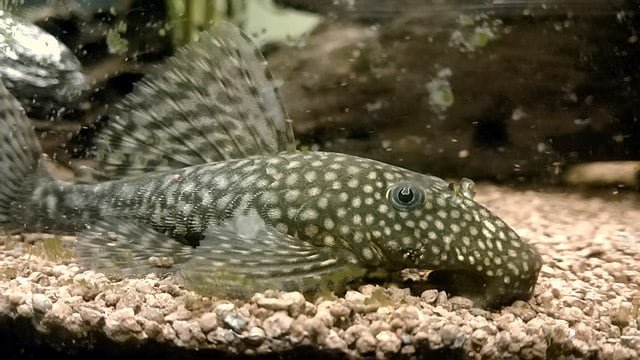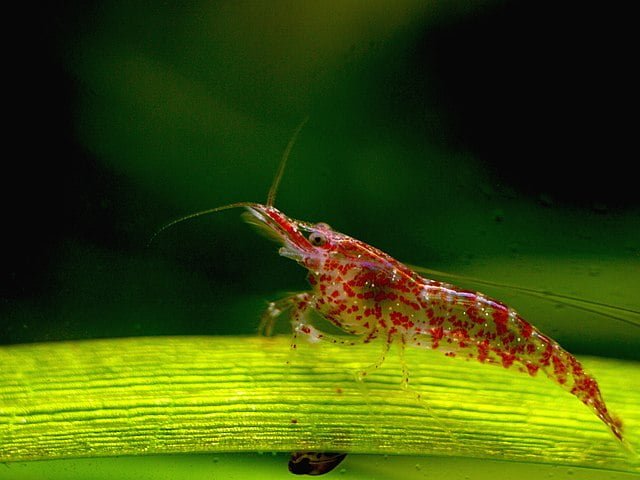Catfish, Silurids, or Bullheads are characterized by their tentacles or barbels, which extend on either side of the mouth, resembling a cat’s whiskers, hence the name ‘catfish.’ These bullheads, with their unique characteristics, have captured the attention of aquarium enthusiasts.
Beyond their importance in the ornamental industry, some catfish species, such as the pangasius and channel catfish, are also being bred through aquaculture techniques for use as human food.
Catfish belong to various families, with the Siluridae family and the Ictalurus genus being some of the most well-known representatives. The most distinctive feature of these fish is their barbels, sensitive structures located around the mouth that enable them to detect food in dark and murky aquatic environments.
Have you ever wondered what makes catfish so special? In this article, we will unravel the secrets of these unique fish and provide you with a guide on their care, feeding, reproduction, and much more, considering the peculiarities of each species.
Taxonomy of Catfish
- 1 Taxonomy of Catfish
-
2
Types of Catfish
- 2.1 Raphael Catfish (Platydoras costatus)
- 2.2 Albino Catfish
- 2.3 Redtail Catfish (Phractocephalus hemioliopterus)
- 2.4 Upside-Down Catfish (Synodontis nigriventris)
- 2.5 Zungaro Catfish (Zungaro zungaro)
- 2.6 Glass Catfish (Kryptopterus bicirrhis)
- 2.7 Spotted Catfish (Agamyxis pectinifrons)
- 2.8 Panda Catfish (Corydoras panda)
- 2.9 Leopard Catfish (Pseudoplatystoma fasciatum x Pseudoplatystoma hemioliopterus)
- 2.10 American Catfish (Ictalurus punctatus)
- 2.11 Vietnamese Catfish (Pangasianodon hypophthalmus)
- 3 Natural Habitat of Catfish
- 4 What Do Catfish Eat?
- 5 How Do Catfish Reproduce?
- 6 Catfish Care: Practical Tips to Ensure Their Well-being
- 7 Diseases Affecting Catfish
- 8 Conclusion
- 9 References
- 10 Entradas relacionadas:
Catfish or bullheads constitute about 2,900 species grouped into 35 families. Here is the taxonomic classification of catfish up to the Order level, as depending on the species, they could belong to different families:
- Kingdom: Animalia
- Phylum: Chordata
- Class: Actinopterygii
- Subclass: Neopterygii
- Infraclass: Teleostei
- Superorder: Ostariophysi
- Order: Siluriformes
- Common Name: Catfish, bullheads, whiskered fish
- English Name: Catfish, catfishes
Types of Catfish
The catfish world is astonishingly diverse. From the giant flathead catfish to the small albino catfish, we will explore the various species inhabiting different continents, with special emphasis on catfish of interest to aquarium enthusiasts.
Catfish come in a significant variety of sizes, from small species like Corydoras (4 or 5 cm) to large species like Silurus glanis (4.5 m). If you plan to have catfish specimens, it’s important to know their space requirements (tank size).
As mentioned earlier, the main characteristic of catfish is their four pairs of barbels: on each side of the mouth and two pairs of barbels on the chin, although this can vary depending on the species.
Stay Always Informed
Join our communities to instantly receive the most important news, reports, and analysis from the aquaculture industry.
Additionally, catfish have a variety of body shapes, although most have cylindrical bodies with a flattened belly. Having a flattened head allows them to dig through the substrate. It’s important to note that these types of fish do not have scales.
Below are the distinctive characteristics of the most important catfish species for the ornamental industry and aquaculture, helping you easily identify them.
Raphael Catfish (Platydoras costatus)
The Raphael catfish, also known as the chocolate catfish, golden chocolate, striped catfish, or Raphael striped catfish (Platydoras costatus), can reach a length of up to 25 cm in adulthood and can live up to 16 years in captivity, with a relatively high economic value in aquarium stores.
The Raphael catfish has an omnivorous diet (plants and organic debris from the tank bottom); although it tends to be carnivorous and is a nocturnal animal (Kusrini et al., 2017). If you’re raising these catfish, you can feed them flakes, pellets, fresh foods (worms), and frozen foods.
The Raphael catfish (P. costatus) is native to the Amazon River basins in South America, and it can be bred at a water temperature of 24 to 30 °C, with a pH of 6.0 – 7.5 and hardness (GH) of 2 to 20.
The striped catfish is suitable for tanks starting from a volume of 100 liters; however, for adults, a minimum of 800 liters is required for a population of 4 fish. In the case of Raphael catfish fry (2.36 cm), Alfiyansyah (2016) recommends that they can be bred at a density of 8 fish per liter of water.
An important feature is that juvenile catfish can form symbiotic relationships with other fish species such as characids (Carvalho et al., 2003), where the Raphael catfish acts as a “cleaner” of parasites from other fish. Raphael catfish (P. costatus) can be bred together with other fish due to its peaceful behavior.
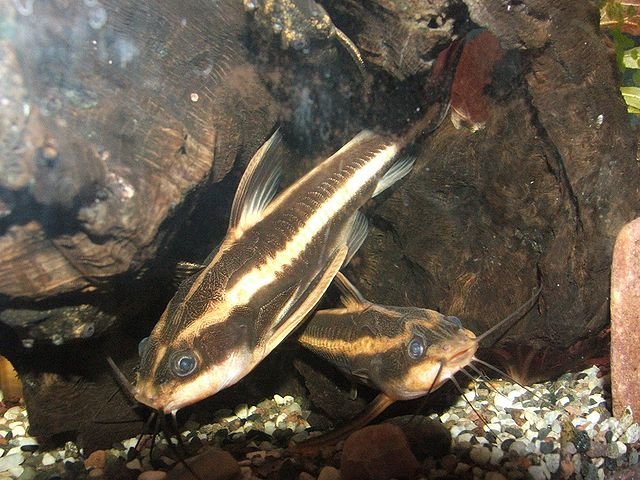
Albino Catfish
The albino catfish, Corydora albino (Corydora aeneus), belongs to the Corydora family and is highly prized by aquarium enthusiasts for its uniqueness. In this article, you can find detailed information about Corydoras catfish.
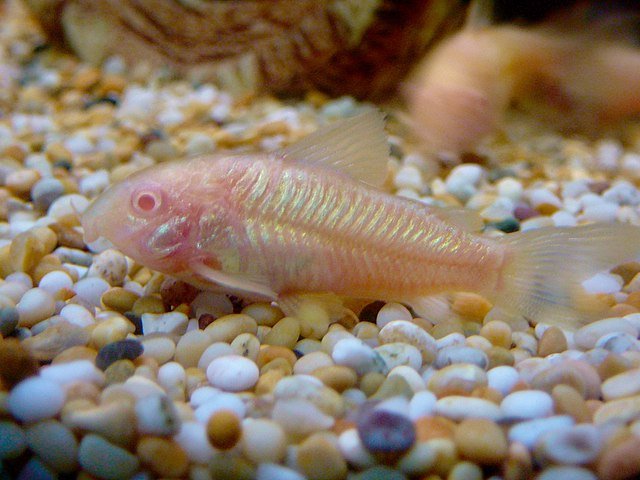
Redtail Catfish (Phractocephalus hemioliopterus)
The Redtail Catfish (Phractocephalus hemioliopterus), also known in the ornamental fish industry as the South American Redtail Catfish, Tower Catfish, “cajaro” (Venezuela and Colombia), or “pirara” (Brazil), is distributed in the basins of the Amazon and Orinoco rivers (Naldoni et al., 2018) and can reach a size of 130 cm in total length and a weight of 80 kilograms.
This catfish is carnivorous, and for its breeding, it requires water with a temperature of 20 to 26 °C, a pH of 5.5 to 6.8, and hardness (GH) of 2 to 10. This catfish is territorial.

Upside-Down Catfish (Synodontis nigriventris)
The Upside-Down Catfish (Synodontis nigriventris), also known as the Upside-Down Catfish, African Upside-Down Catfish, or Inverted Catfish, earns its name from its swimming behavior, as it enjoys swimming with its belly up or on its side. This fish is native to Central Africa.
The Upside-Down Catfish is benthic, displaying nocturnal habits and feeding on small invertebrates (water fleas, worms) and algae. Unlike other catfish species, the Upside-Down Catfish can reach a maximum length of 9.6 cm.
Ideal for small aquariums, the Upside-Down Catfish should be kept in groups of 3 or more. These fish thrive in water temperatures ranging from 22 to 27 °C, with a pH between 6.0 – 8.0 and a hardness of 5 – 20 dH.

Zungaro Catfish (Zungaro zungaro)
The Zungaro Catfish, also known as the Painted Catfish, Bagresapo, Dorado, or Doncella (Zungaro zungaro), is distributed in the basins of the Amazon and Orinoco rivers, where it sustains important fisheries. However, Zungaro is also being produced through aquaculture techniques, albeit in a nascent stage.
The Zungaro, also known as Manguruyú, can reach a total length of 130 cm. It is an omnivorous catfish, although it has a preference for small crustaceans and fish. For breeding, bodies of water with a temperature between 20 and 24 °C are required.

Glass Catfish (Kryptopterus bicirrhis)
The Glass Catfish (Kryptopterus bicirrhis), also known as “bicirri,” “glass fish,” “featherfin catfish,” “glass catfish,” “ghost catfish,” and “Java glass,” is native to Cambodia, Vietnam, Java, Borneo, India, and Thailand. This glass catfish can reach a maximum length of 15 cm, is omnivorous, and can live for 7 years.
The glass catfish is peaceful and gregarious, best raised in groups of 6 fish in tanks with a minimum length of 80 cm. The aquarium water should have a temperature between 20 and 25 °C, a pH between 6.5 – 7.5, and a hardness of around 10 dGH.

Spotted Catfish (Agamyxis pectinifrons)
The Spotted Catfish (Agamyxis pectinifrons), also known as the “Spotted Dora” or “rego-rego,” can reach a length between 10 and 14 cm and live up to 10 years. Females have a more rounded abdomen than males. This catfish is carnivorous and solitary.
The spotted catfish is native to the Amazon River basin, requiring a water temperature of 20 to 26 °C, a pH of 6 – 7.5, and a hardness of 3 – 10 GH.

Panda Catfish (Corydoras panda)
The Panda Catfish, also known as Corydoras panda, is covered in more detail in this article about Corydoras.
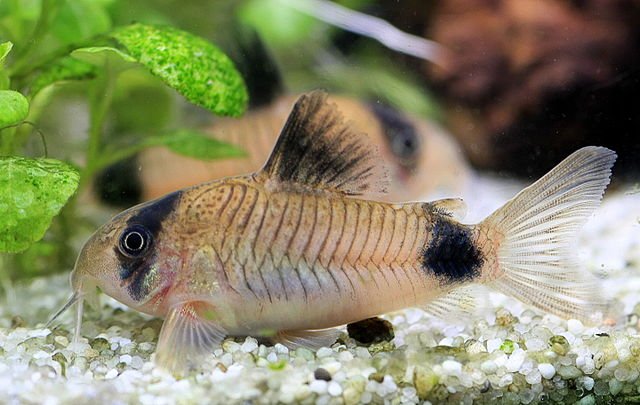
Leopard Catfish (Pseudoplatystoma fasciatum x Pseudoplatystoma hemioliopterus)
The Leopard Catfish is a hybrid of the Tiger Catfish (Pseudoplatystoma fasciatum) x Redtail Catfish (Pseudoplatystoma hemioliopterus). The phenotype of the Leopard Catfish exhibits a better color pattern compared to the Tiger Catfish and may increase its economic value (Kusrini and Priyadi, 2010).
American Catfish (Ictalurus punctatus)
The American Catfish (Ictalurus punctatus), or Channel Catfish, is native to the United States. This catfish is widely consumed by the population and is currently being produced through aquaculture. In the following article, you can find some experiences with transgenic channel catfish.
Vietnamese Catfish (Pangasianodon hypophthalmus)
The Vietnamese Catfish (Pangasianodon hypophthalmus), also known as Panga or Swai Catfish, is one of the catfish species with the highest production volume through aquaculture, primarily in Vietnam. However, its cultivation is being promoted in many countries. If you want to learn more about the Vietnamese Catfish, you can check out this article.
Natural Habitat of Catfish
Catfish species inhabit freshwater and coastal waters worldwide, with the greatest diversity found in tropical areas of South America, Asia, and Africa. However, it’s noteworthy that half of all catfish species live in the Americas.
Some species of the Ictalurus genus have been introduced to European waters for sport fishing, but their populations have grown uncontrollably, becoming a nuisance. On the other hand, Pangasius catfish is also being introduced in many countries for aquaculture purposes due to its resistance and high production potential.
While many catfish populations are abundant, some species face threats due to habitat loss, water pollution, and the introduction of invasive species. Conservation efforts for these fish are crucial to maintaining the health of aquatic ecosystems and ensuring their long-term survival.
What Do Catfish Eat?
Proper nutrition is crucial for the health and vitality of your catfish. Understanding the feeding habits of catfish is important to provide them with an ideal diet to keep these fish happy and healthy.
An important feature of catfish is their mouth, which can expand to a large size and does not contain teeth. Additionally, most catfish species feed at the bottom of aquariums or ponds. Therefore, you should choose sinking pellets to ensure the fish can make the most of their food.
Catfish typically feed by suction or swallowing rather than biting. However, it’s worth noting that some families have a sucker mouth that allows them to attach to objects in rapidly moving waters.
How Do Catfish Reproduce?
Various studies have reported that approximately half of all catfish families exhibit sexual dimorphism. Scientists have also reported the modification of the anal fin into a reproductive organ.
However, there is no standard protocol for catfish reproduction due to the diversity of species. Each catfish species has specific reproductive behavior, and in many species, captive breeding has not been achieved.
Nevertheless, attempts at artificial reproduction of catfish have been recorded. Sipos et al., (2019) evaluated the use of cGnRH IIa and Ovaprim in the spawning performance of the Synodontis catfish (Synodontis nigriventris and Synodontis eupterus), reporting that 50 μg/kg cGnRH IIa triggers ovulation.
Catfish Care: Practical Tips to Ensure Their Well-being
The well-being of your catfish is of utmost importance. Ensuring the quality of the water in the tank where you will raise your catfish is crucial.
Considering that catfish are creatures that live at the bottom of the aquarium, make sure the substrate does not have stones or other objects that could harm your fish. Provide some hiding spots for catfish varieties with nocturnal behaviors.
The compatibility of catfish will depend on the species you choose to raise. You have a choice from the peaceful Glass Catfish to the territorial Redtail Catfish. The design you choose for your aquarium will determine the species to select.
Diseases Affecting Catfish
Parasites
The Raphael Catfish (Platydoras costatus) can be parasitized by the Proteocephalus tapeworm (de Chambrier and Vaucher, 1994). Naldoni et al., (2018) reported that the Redtail Catfish (Phractocephalus hemioliopterus) is parasitized by 2 myxobolids (Myxobolus figueirae sp. nov. and Henneguya santarenensis sp. nov.) that infect the skin and gill filaments of the fish.
Ectoparasites often create wounds on the skin of catfish that can become entry points for diseases. Andrade et al., (2023) determined that once an ectoparasite is identified, it can be manually removed, and the catfish should be treated with 10 grams of potassium permanganate and 2 grams of methylene blue per cubic meter until the wounds completely disappear.
Vibriosis
Catfish, like other fish, are susceptible to vibriosis, a disease caused by Vibrio bacteria. The main features of diseased fish with vibriosis include dropsy, exophthalmia, scale detachment, and hemorrhaging on the body surface.
Saad et al., (2015) stated that vibriosis can be treated with antibiotics such as oxytetracycline, neomycin, and erythromycin.
Conclusion
In conclusion, this extensive journey through the world of catfish has revealed a wealth of essential information for all aquarium enthusiasts. From the different types of catfish to their feeding habits, reproduction, and care, you now have the knowledge necessary to care for and appreciate these fascinating aquatic inhabitants.
You can find a wide variety of catfish in stores to choose from. However, take the time to make a careful selection so that you don’t have any unpleasant surprises in the end.
At Aquahoy, we believe in providing valuable and reliable information. We hope this article has answered all your questions about catfish and sparked your curiosity to explore even more wonders of the aquatic world. Stay tuned for more exciting and educational content in our aquatic community!
References
Alfiyansyah, M. (2016). Pertumbuhan dan kelangsungan hidup Benih Ikan Platidoras Platydoras costatus pada padat penebaran 2, 4, 6 dan 8 Ekor Per-Liter. IPB University.
Andrade, R. B., Fernandes, M. P., Rezende, M. T. N. P., Alves, T. R. de O., & Rodrigues, L. (2023). Uso do azul de metileno e permanganato de potássio em lesão cutânea de Phractocephalus Hemioliopterus. Pubvet, 17(04), e1371. https://doi.org/10.31533/pubvet.v17n04e1371
Carvalho, L. N., Arruda, R., & Zuanon, J. (2003). Record of cleaning behavior by Platydoras costatus (Siluriformes: Doradidae) in the Amazon Basin, Brazil. Neotropical Ichthyology, 1, 137-139.
de Chambrier, A., & Vaucher, C. (1994). Etude morpho-anatomique et génétique de deux nouveaux Proteocephalus Weinland, 1858 (Cestoda: Proteocephalidae) parasites de Platydoras costatus (L.), poisson siluriforme du Paraguay. Systematic Parasitology, 27, 173-185.
Kusrini, E., & Priyadi, A. (2010, March). FENOTIP GENERASI PERTAMA DARI HASIL HIBRIDISASI ANTARA TIGER CATFISH (Pseudoplatystoma fasciatum) DENGAN RED TAIL CATFISH (Phractocephalus hemioliopterus). In Prosiding FORUM INOVASI TEKNOLOGI AKUAKULTUR (Vol. 1, No. 1, pp. 571-577).
Kusrini, E., Priyadi, A., Wibowo, G. S., & Insan, I. (2017, April). STUDI TENTANG PEMELIHARAAN LARVA IKAN HIAS STRIPEDRAPHAEL CATFISH (Platydoras costatus). In Prosiding FORUM INOVASI TEKNOLOGI AKUAKULTUR (pp. 547-551).
Naldoni J, Maia AAM, Correa LL, Silva MRM, Adriano EA (2018) New myxosporeans parasitizing Phractocephalus hemioliopterus from Brazil: morphology, ultrastructure and SSU-rDNA sequencing. Dis Aquat Org 128:37-49. https://doi.org/10.3354/dao03210
SAAD EL-DEEN, A. Y. A., & A ELKAMEL, A. H. M. A. D. (2015). Clinical and experimental study on vibriosis in ornamental fish. Assiut Veterinary Medical Journal, 61(146), 147-153.
Sipos, M. J., Lipscomb, T. N., Wood, A. L., Ramee, S. W., Watson, C. A., & DiMaggio, M. A. (2019). Evaluation of cGnRH IIa for induction spawning of two ornamental Synodontis species. Aquaculture, 511, 734226.
Editor at the digital magazine AquaHoy. He holds a degree in Aquaculture Biology from the National University of Santa (UNS) and a Master’s degree in Science and Innovation Management from the Polytechnic University of Valencia, with postgraduate diplomas in Business Innovation and Innovation Management. He possesses extensive experience in the aquaculture and fisheries sector, having led the Fisheries Innovation Unit of the National Program for Innovation in Fisheries and Aquaculture (PNIPA). He has served as a senior consultant in technology watch, an innovation project formulator and advisor, and a lecturer at UNS. He is a member of the Peruvian College of Biologists and was recognized by the World Aquaculture Society (WAS) in 2016 for his contribution to aquaculture.


